GitHub Actions in Action
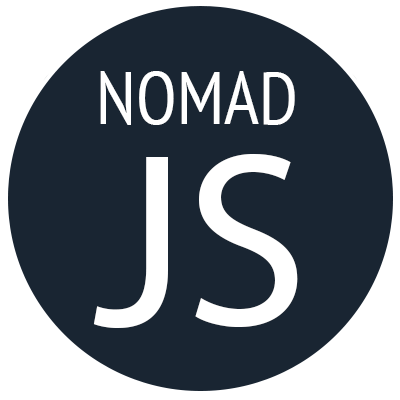

Gleb Bahmutov
VP of Engineering
Cypress.io
In this presentation I will show how simple the continuos integration can be with GitHub Actions. They are powerful, have generous limits for public repositories and can be easily reused
our planet is in imminent danger
https://lizkeogh.com/2019/07/02/off-the-charts/
+3 degrees Celsius will be the end.
we have to act today
ME
you
you
you
you
- home on green electricity
- ebike everywhere
- online conferences instead of flying
we have to act today
ME
you
you
you
you
if I can help I will
@bahmutov
gleb.bahmutov@gmail.com
If there is a company that fights global climate catastrophe and needs JavaScript and testing skills - I will do for free.
Example: https://fab.earth
Based on the blog post https://glebbahmutov.com/blog/trying-github-actions/
Contents
-
What are GitHub (GH) Actions
-
Hello world example
-
Fixing code formatting
-
Testing Node code
-
Caching
-
Writing your own action
-
-
Testing web apps using Cypress
-
Linux / Mac / Windows
-
parallelization
-
- Hundreds of OSS projects at gleb.dev
- Hundreds of blog posts at gleb.dev/blog
- VP of Engineering at Cypress.io
- https://slides.com/bahmutov/github-actions-in-action
Dr. Gleb Bahmutov, PhD
these slides
Continuous integration (CI): every commit should be built and tested automatically in a clean environment.
Coding without CI is like never changing the oil in your car. It is just a matter of time before it blows up.
me (paraphrasing Justin James)
from https://cypress.slides.com/cypress-io/cypress-on-ci
Lots of CI providers
- Travis
- CircleCI
- BuildKite
- Semaphore
- AppVeyor
- GitLab
- Codeship
- AzureCI
- Shippable
- Jenkins*
- TeamCity*
* self-managed
NOT WORTH IT
Every CI config file
- git checkout
- install dependencies and tools
- build code
- start app
- test app
- report results
Every CI config file
- git checkout
- install dependencies and tools
- build code
- start app
- test app
- report results
caching!!!
Every CI config file
- git checkout
- install dependencies and tools
- build code
- start app
- test app
- report results
caching!!!
when is it ready?
how to stop it?
Every CI config file
- git checkout
- install dependencies and tools
- build code
- start app
- test app
- report results
caching!!!
when is it ready?
how to stop it?
in parallel?
CI setup: dream
Reality 🤯
version: 2
jobs:
test:
docker:
- image: cypress/base:10
steps:
- checkout
# restore folders with npm dependencies and Cypress binary
- restore_cache:
keys:
- cache-{{ checksum "package.json" }}
# install npm dependencies and Cypress binary
# if they were cached, this step is super quick
- run:
name: Install dependencies
command: npm ci
- run: npm run cy:verify
# save npm dependencies and Cypress binary for future runs
- save_cache:
key: cache-{{ checksum "package.json" }}
paths:
- ~/.npm
- ~/.cache
# start server before starting tests
- run:
command: npm start
background: true
- run: npm run e2e:record
workflows:
version: 2
build:
jobs:
- testDocker image
Caching
Caching
Install
run tests
maybe start app
Typical front-end web app testing using Cypress
defaults: &defaults
working_directory: ~/app
docker:
- image: cypress/browsers:chrome67
version: 2
jobs:
build:
<<: *defaults
steps:
- checkout
# find compatible cache from previous build,
# it should have same dependencies installed from package.json checksum
- restore_cache:
keys:
- cache-{{ .Branch }}-{{ checksum "package.json" }}
- run:
name: Install Dependencies
command: npm ci
# run verify and then save cache.
# this ensures that the Cypress verified status is cached too
- run: npm run cy:verify
# save new cache folder if needed
- save_cache:
key: cache-{{ .Branch }}-{{ checksum "package.json" }}
paths:
- ~/.npm
- ~/.cache
- run: npm run types
- run: npm run stop-only
# all other test jobs will run AFTER this build job finishes
# to avoid reinstalling dependencies, we persist the source folder "app"
# and the Cypress binary to workspace, which is the fastest way
# for Circle jobs to pass files
- persist_to_workspace:
root: ~/
paths:
- app
- .cache/Cypress
4x-electron:
<<: *defaults
# tell CircleCI to execute this job on 4 machines simultaneously
parallelism: 4
steps:
- attach_workspace:
at: ~/
- run:
command: npm start
background: true
# runs Cypress test in load balancing (parallel) mode
# and groups them in Cypress Dashboard under name "4x-electron"
- run: npm run e2e:record -- --parallel --group $CIRCLE_JOB
workflows:
version: 2
# this workflow has 4 jobs to show case Cypress --parallel and --group flags
# "build" installs NPM dependencies so other jobs don't have to
# └ "1x-electron" runs all specs just like Cypress pre-3.1.0 runs them
# └ "4x-electron" job load balances all specs across 4 CI machines
# └ "2x-chrome" load balances all specs across 2 CI machines and uses Chrome browser
build_and_test:
jobs:
- build
# this group "4x-electron" will load balance all specs
# across 4 CI machines
- 4x-electron:
requires:
- buildParallel config is ... more complicated
- install + run jobs
- workspace
- parallel flags
Typical front-end web app testing using Cypress
# all jobs that actually run tests can use the same definition
job_template: &job_template
image: cypress/base:10
stage: test
script:
# print CI environment variables for reference
- $(npm bin)/print-env CI
# start the server in the background
- npm run start:ci &
# run Cypress test in load balancing mode
- npm run e2e:record -- --parallel --group "electrons on GitLab CI"
artifacts:
when: always
paths:
- cypress/videos/**/*.mp4
- cypress/screenshots/**/*.png
expire_in: 1 day
# actual job definitions
# all steps are the same, they come from the template above
electrons-1:
<<: *job_template
electrons-2:
<<: *job_template
electrons-3:
<<: *job_template
electrons-4:
<<: *job_template
electrons-5:
<<: *job_template
YAML tips & tricks
Copy / paste / tweak until CI passes 🙁
# first, install Cypress, then run all tests (in parallel)
stages:
- build
- test
# to cache both npm modules and Cypress binary we use environment variables
# to point at the folders we can list as paths in "cache" job settings
variables:
npm_config_cache: "$CI_PROJECT_DIR/.npm"
CYPRESS_CACHE_FOLDER: "$CI_PROJECT_DIR/cache/Cypress"
# cache using branch name
# https://gitlab.com/help/ci/caching/index.md
cache:
key: ${CI_COMMIT_REF_SLUG}
paths:
- .npm
- cache/Cypress
- node_modules
# this job installs NPM dependencies and Cypress
install:
image: cypress/base:10
stage: build
script:
- npm ci
- $(npm bin)/print-env CI
- npm run cy:verify
# all jobs that actually run tests can use the same definition
.job_template: &job
image: cypress/base:10
stage: test
script:
# print CI environment variables for reference
- $(npm bin)/print-env CI
# start the server in the background
- npm run start:ci &
# run Cypress test in load balancing mode, pass id to tie jobs together
- npm run e2e:record -- --parallel --ci-build-id $CI_PIPELINE_ID --group electrons
# actual job definitions
# all steps are the same, they come from the template above
electrons-1:
<<: *job
electrons-2:
<<: *job
electrons-3:
<<: *job
electrons-4:
<<: *job
electrons-5:
<<: *jobpipeline {
agent {
// this image provides everything needed to run Cypress
docker {
image 'cypress/base:10'
}
}
stages {
// first stage installs node dependencies and Cypress binary
stage('build') {
steps {
// there a few default environment variables on Jenkins
// on local Jenkins machine (assuming port 8080) see
// http://localhost:8080/pipeline-syntax/globals#env
echo "Running build ${env.BUILD_ID} on ${env.JENKINS_URL}"
sh 'npm ci'
sh 'npm run cy:verify'
}
}
stage('start local server') {
steps {
// start local server in the background
// we will shut it down in "post" command block
sh 'nohup npm start &'
}
}
// this tage runs end-to-end tests, and each agent uses the workspace
// from the previous stage
stage('cypress parallel tests') {
environment {
// we will be recordint test results and video on Cypress dashboard
// to record we need to set an environment variable
// we can load the record key variable from credentials store
// see https://jenkins.io/doc/book/using/using-credentials/
CYPRESS_RECORD_KEY = credentials('cypress-example-kitchensink-record-key')
// because parallel steps share the workspace they might race to delete
// screenshots and videos folders. Tell Cypress not to delete these folders
CYPRESS_trashAssetsBeforeRuns = 'false'
}
// https://jenkins.io/doc/book/pipeline/syntax/#parallel
parallel {
// start several test jobs in parallel, and they all
// will use Cypress Dashboard to load balance any found spec files
stage('tester A') {
steps {
echo "Running build ${env.BUILD_ID}"
sh "npm run e2e:record:parallel"
}
}
// second tester runs the same command
stage('tester B') {
steps {
echo "Running build ${env.BUILD_ID}"
sh "npm run e2e:record:parallel"
}
}
}
}
}
post {
// shutdown the server running in the background
always {
echo 'Stopping local server'
sh 'pkill -f http-server'
}
}
}language: node_js
node_js:
# Node 10.3+ includes npm@6 which has good "npm ci" command
- 10.8
cache:
# cache both npm modules and Cypress binary
directories:
- ~/.npm
- ~/.cache
override:
- npm ci
- npm run cy:verify
defaults: &defaults
script:
# ## print all Travis environment variables for debugging
- $(npm bin)/print-env TRAVIS
- npm start -- --silent &
- npm run cy:run -- --record --parallel --group $STAGE_NAME
# after all tests finish running we need
# to kill all background jobs (like "npm start &")
- kill $(jobs -p) || true
jobs:
include:
# we have multiple jobs to execute using just a single stage
# but we can pass group name via environment variable to Cypress test runner
- stage: test
env:
- STAGE_NAME=1x-electron
<<: *defaults
# run tests in parallel by including several test jobs with same name variable
- stage: test
env:
- STAGE_NAME=4x-electron
<<: *defaults
- stage: test
env:
- STAGE_NAME=4x-electron
<<: *defaults
- stage: test
env:
- STAGE_NAME=4x-electron
<<: *defaults
- stage: test
env:
- STAGE_NAME=4x-electron
<<: *defaultsDifferent CIs
First great reusable CI code
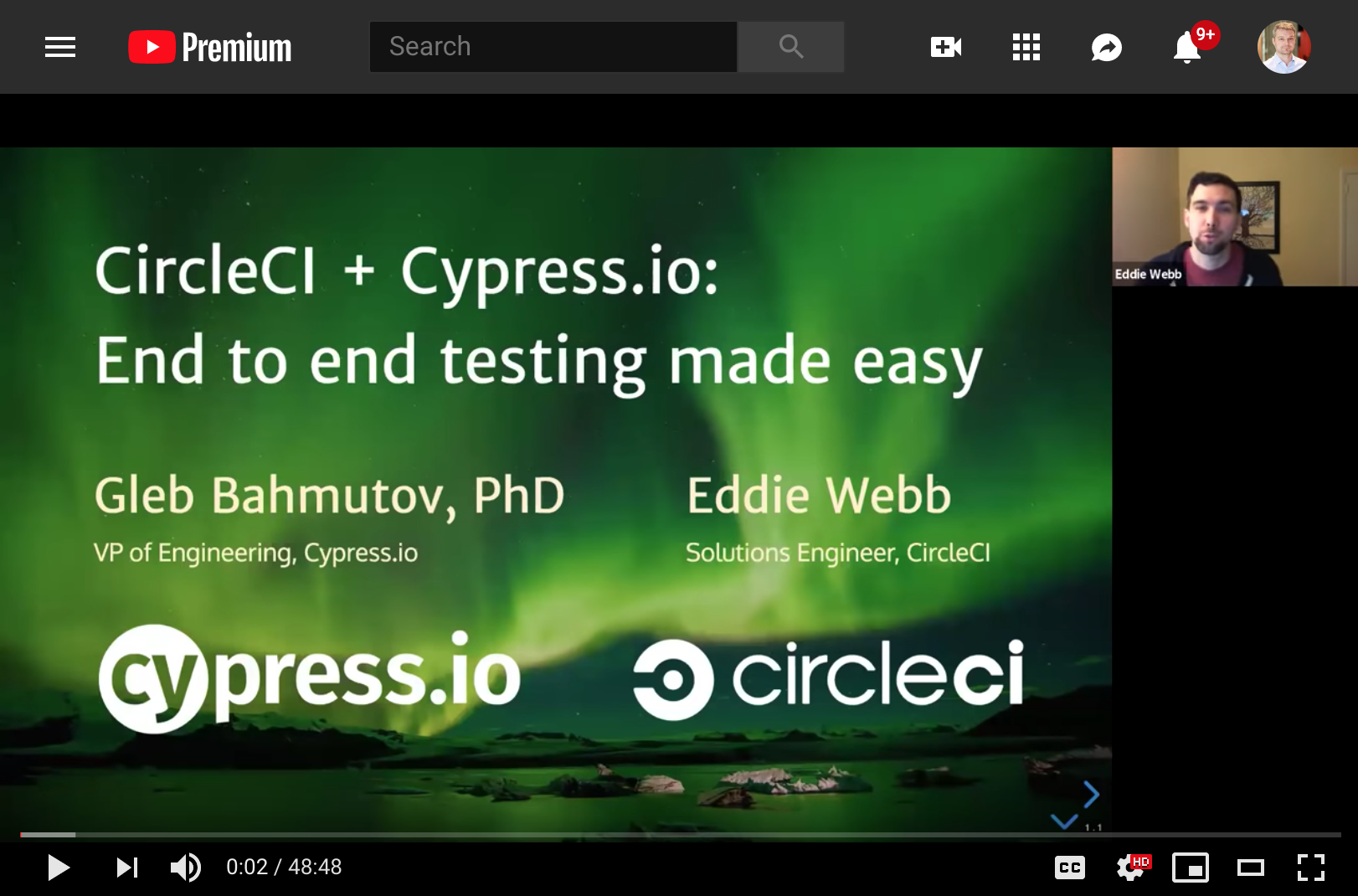
GitHub Actions v2
🎉 GitHub Actions v2 🎉
Hello World workflow
repo/
.github/
ISSUE_TEMPLATE.md
PULL_REQUEST_TEMPLATE.md
workflows/
hello.yml
.github/workflows/hello.yml
name: Hello
on: [push]
jobs:
hello:
runs-on: ubuntu-latest
steps:
- run: echo Hello World!.github/workflows/hello.yml
name: Hello
on: [push]
jobs:
hello:
runs-on: ubuntu-latest
steps:
- run: echo Hello World!- commit pushed
- pull request opened / closed/ etc
- chron job
- other
.github/workflows/hello.yml
name: Hello
on: [push]
jobs:
hello:
runs-on: ubuntu-latest
steps:
- run: echo Hello World!- hello job
- multiple jobs supported
- jobs can depend on other jobs
.github/workflows/hello.yml
name: Hello
on: [push]
jobs:
hello:
runs-on: ubuntu-latest
steps:
- run: echo Hello World!- run on Linux, Windows, Mac
- run in a given Docker image
Tip 💡: workflows badge
https://github.com/<OWNER>/<REPOSITORY>/workflows/<WORKFLOW_NAME>/badge.svg?branch=<BRANCH>
# example

Markdown text
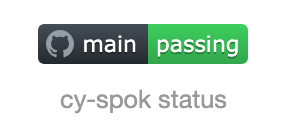
.github/workflows/docs.yml
name: Publish docs
on:
push:
branches:
- master
paths:
- 'docs/**'
jobs:
docs:
runs-on: ubuntu-latest
steps:
...- run workflow if some files change
Tip 💡: multiple workflows
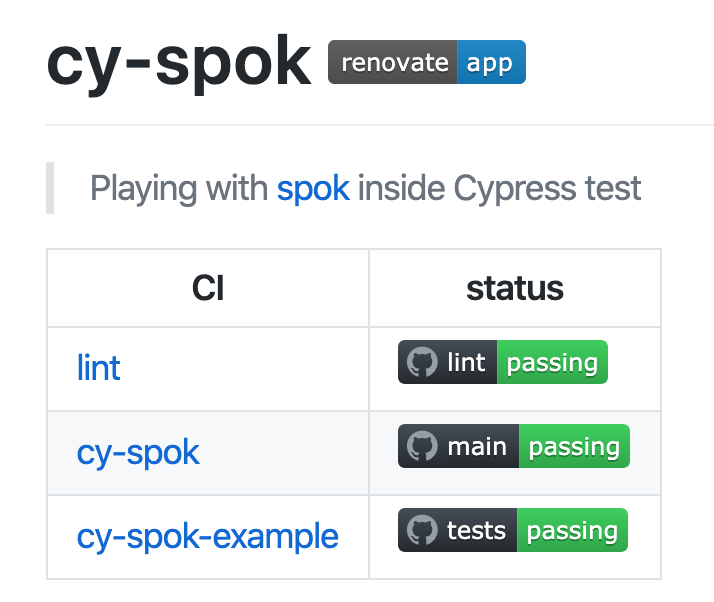
GitHub integration 💪
- code checkout
- CI steps
- ...
- push code updates?!!
GH Actions are linked to the repo via GitHub Actions app installed automatically
automatic GITHUB_TOKEN
Code formatting with Prettier
{
"scripts": {
"format": "prettier --write 'src/*.js'"
},
"devDependencies": {
"husky": "3.0.5",
"lint-staged": "9.2.5",
"prettier": "1.18.2"
},
"husky": {
"hooks": {
"pre-commit": "lint-staged"
}
},
"lint-staged": {
"*.js": ["prettier --write", "git add"]
}
}but people (even I) forget
.github/workflows/ci.yml
name: Prettier
on: [push]
jobs:
build:
name: Prettier
runs-on: ubuntu-latest
steps:
- uses: actions/checkout@v1
- uses: bahmutov/npm-install@v1
- run: npm run format
- run: git status
# commit any changed files
# https://github.com/mikeal/publish-to-github-action
- uses: mikeal/publish-to-github-action@master
env:
GITHUB_TOKEN: ${{ secrets.GITHUB_TOKEN }}3rd party actions, each is
GH owner / repo @ commitish
.github/workflows/ci.yml
name: Prettier
on: [push]
jobs:
build:
name: Prettier
runs-on: ubuntu-latest
steps:
- uses: actions/checkout@v1
- uses: bahmutov/npm-install@v1
- run: npm run format
- run: git status
# commit any changed files
# https://github.com/mikeal/publish-to-github-action
- uses: mikeal/publish-to-github-action@master
env:
GITHUB_TOKEN: ${{ secrets.GITHUB_TOKEN }}3rd party action with passed GH token, can push code!
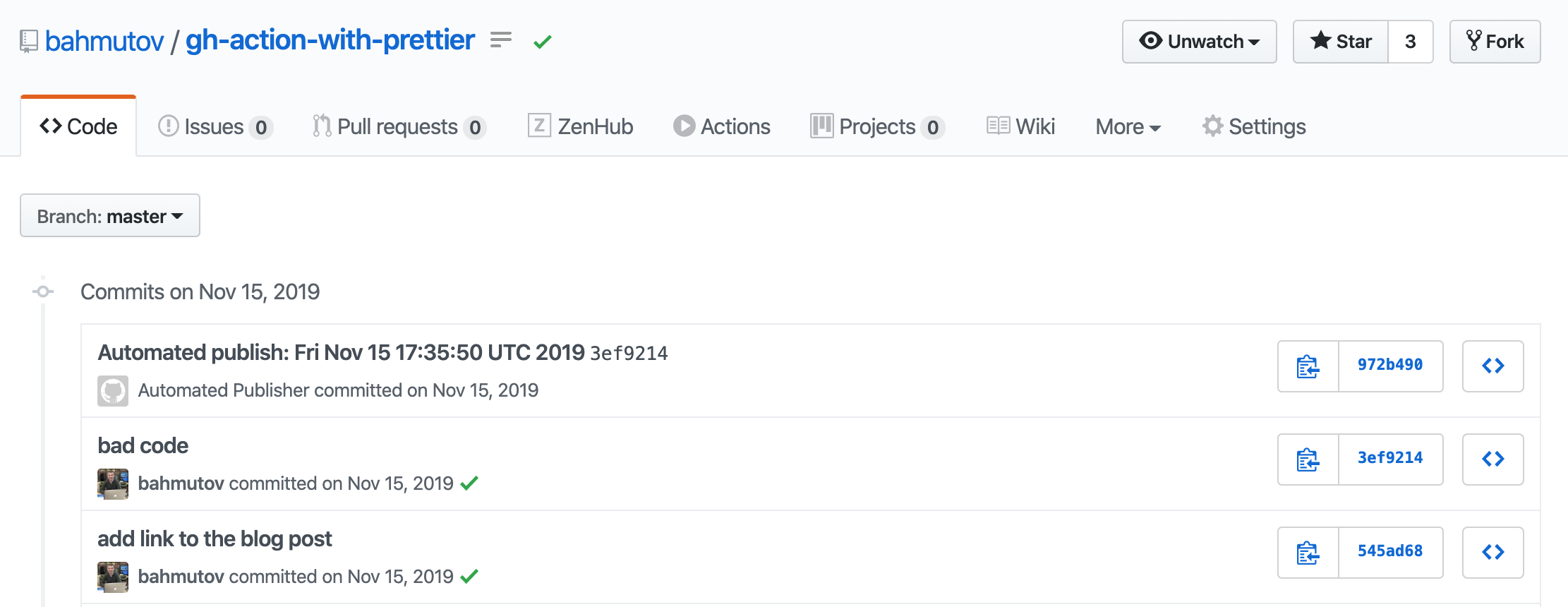
commit by action from workflow



Commit from GH Workflow
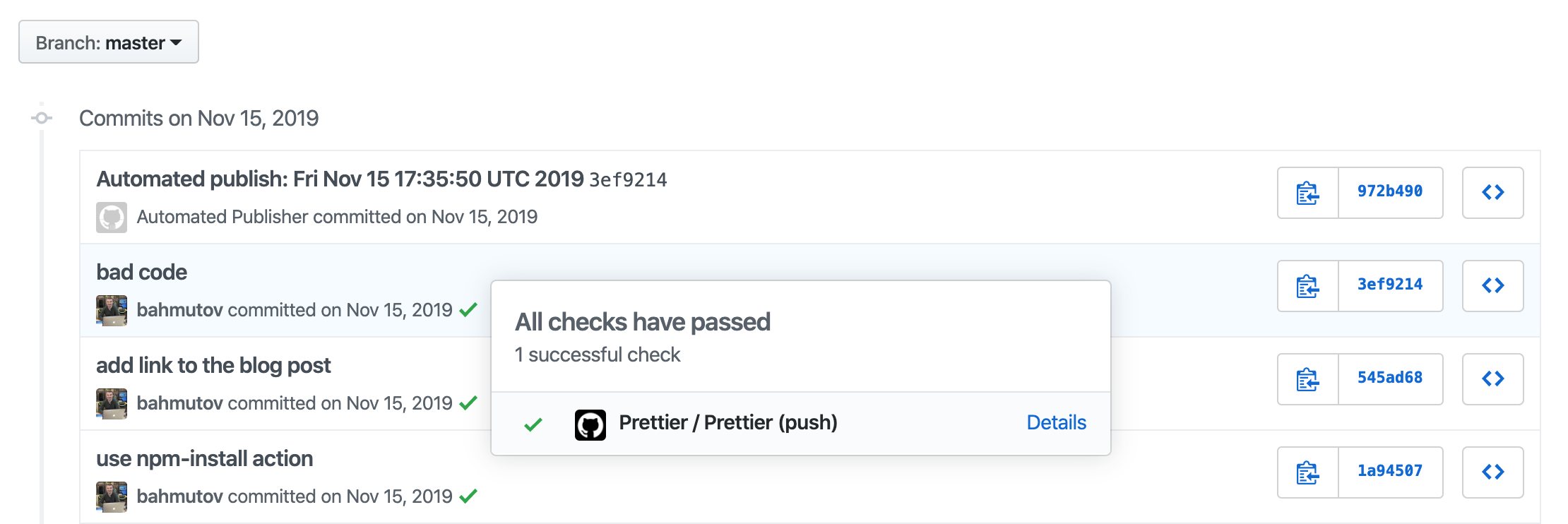
⚠️ there is no workflow triggered for the commit created from GH Action
Automated workflows cannot trigger other automated workflows (to avoid cycles?). Example: you can automatically open a PR but not close it.
https://github.com/mikeal/publish-to-github-action
#!/bin/sh
# check values
if [ -z "${GITHUB_TOKEN}" ]; then
echo "error: not found GITHUB_TOKEN"
exit 1
fi
# initialize git
remote_repo="https://${GITHUB_ACTOR}:${GITHUB_TOKEN}@github.com/${GITHUB_REPOSITORY}.git"
git config user.name "Automated Publisher"
git config user.email "publish-to-github-action@users.noreply.github.com"
git remote add publisher "${remote_repo}"
git show-ref # useful for debugging
git branch --verbose
# install lfs hooks
git lfs install
# publish any new files
git checkout master
git add -A
timestamp=$(date -u)
git commit -m "Automated publish: ${timestamp} ${GITHUB_SHA}" || exit 0
git pull --rebase publisher master
git push publisher master#!/bin/sh
# check values
if [ -z "${GITHUB_TOKEN}" ]; then
echo "error: not found GITHUB_TOKEN"
exit 1
fi
# initialize git
remote_repo="https://${GITHUB_ACTOR}:${GITHUB_TOKEN}@github.com/${GITHUB_REPOSITORY}.git"
git config user.name "Automated Publisher"
git config user.email "publish-to-github-action@users.noreply.github.com"
git remote add publisher "${remote_repo}"
git show-ref # useful for debugging
git branch --verbose
# install lfs hooks
git lfs install
# publish any new files
git checkout master
git add -A
timestamp=$(date -u)
git commit -m "Automated publish: ${timestamp} ${GITHUB_SHA}" || exit 0
git pull --rebase publisher master
git push publisher master.github/workflows/ci.yml
name: Prettier
on: [push]
jobs:
build:
name: Prettier
runs-on: ubuntu-latest
steps:
- uses: actions/checkout@v1
- uses: bahmutov/npm-install@v1
- run: npm run format
- run: git status
# commit any changed files
# https://github.com/mikeal/publish-to-github-action
- uses: mikeal/publish-to-github-action@master
env:
GITHUB_TOKEN: ${{ secrets.GITHUB_TOKEN }}3rd party GH action
GH Actions isolate complexity
3rd party GitHub Actions are a way to write CI code using JavaScript / TypeScript / anything
You
Tool's author
- uses: actions/checkout@v1
- name: Cache node modules
uses: actions/cache@v1
with:
path: ~/.npm
key: ${{ runner.os }}-node-${{ hashFiles('**/package-lock.json') }}
restore-keys: ${{ runner.os }}-node-
- run: npm ci
- run: npm testNPM or Yarn install yourself
writer: You
ughh, I never remember these
NPM or Yarn install
const hasha = require('hasha')
// we are using dependency
// "cache": "github:cypress-io/github-actions-cache#8bec6cc"
const { restoreCache, saveCache } = require('cache/lib/index')
const useYarn = fs.existsSync('yarn.lock')
const lockFilename = useYarn ? 'yarn.lock' : 'package-lock.json'
const lockHash = hasha.fromFileSync(lockFilename)
const platformAndArch = `${process.platform}-${process.arch}`
// this is simplified code for clarity
// see action file index.js for full details
const NPM_CACHE = {
inputPath: '~/.npm', // or '~/.cache/yarn'
primaryKey: `npm-${platformAndArch}-${lockHash}`,
restoreKeys: `npm-${platformAndArch}-`
}
const restoreCachedNpm = () => {
console.log('trying to restore cached NPM modules')
return restoreCache(
NPM_CACHE.inputPath,
NPM_CACHE.primaryKey,
NPM_CACHE.restoreKeys
)
}
const saveCachedNpm = () => {
console.log('saving NPM modules')
return saveCache(NPM_CACHE.inputPath, NPM_CACHE.primaryKey)
}restoreCachedNpm()
.then(npmCacheHit => {
console.log('npm cache hit', npmCacheHit)
return install().then(() => {
if (npmCacheHit) {
return
}
return saveCachedNpm()
})
})
.catch(error => {
console.log(error)
core.setFailed(error.message)
})Write regular code to do things on CI
Describe action
name: 'NPM or Yarn install with caching'
description: 'Install npm dependencies with caching'
author: 'Gleb Bahmutov'
runs:
using: 'node12'
main: 'dist/index.js'
branding:
color: 'yellow'
icon: 'command'Declare your action in repo file

- uses: actions/checkout@v1
- uses: bahmutov/npm-install@v1
- run: npm testNPM or Yarn install
writer: Me
user: You
.github/workflows/ci.yml
name: Prettier
on: [push]
jobs:
build:
name: Prettier
runs-on: ubuntu-latest
steps:
- uses: actions/checkout@v1
- uses: bahmutov/npm-install@v1
- run: npm run format
- run: git status
# commit any changed files
# https://github.com/mikeal/publish-to-github-action
- uses: mikeal/publish-to-github-action@master
env:
GITHUB_TOKEN: ${{ secrets.GITHUB_TOKEN }}- restore NPM cache
- install NPM deps
- save cache if needed
steps:
# latest commit from a branch (DO NOT USE)
- uses: actions/setup-node@master
# Reference the major version of a release branch
# (I use this)
- uses: actions/setup-node@v1
# # Reference a minor version of a release (if exists)
- uses: actions/setup-node@v1.2
# Reference a specific commit (very strict)
- uses: actions/setup-node@74bc508Tip 💡: control the version
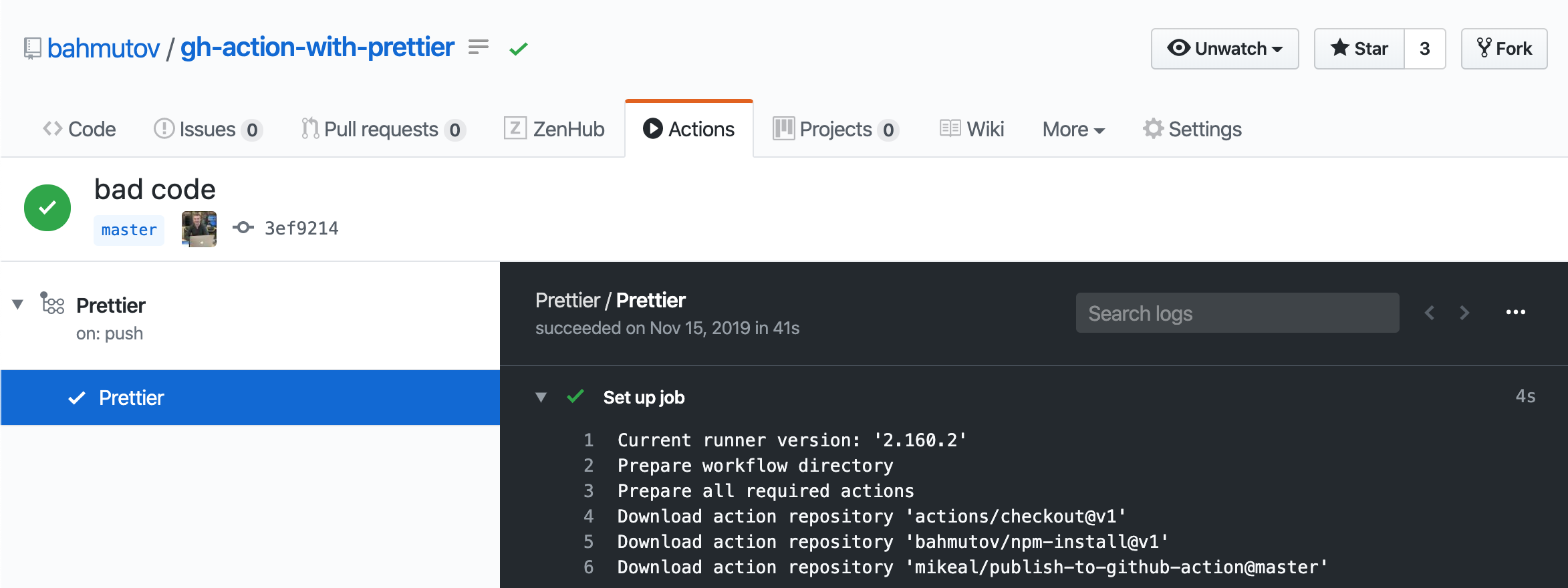
Each GH Action needs to be self-contained and ready to go.
If you use NPM deps, build a single bundle using @zeit/ncc
ncc build -o dist index.js
good example: https://github.com/bahmutov/npm-install
If you want to write your action:

The GitHub Actions ToolKit provides a set of packages to make creating actions easier.
Test on specific Node version
steps:
- uses: actions/checkout@v1
- uses: actions/setup-node@v1
with:
node-version: '10.x'
- run: npm install
- run: npm testTest on many Node versions
jobs:
build:
runs-on: ubuntu-16.04
strategy:
matrix:
node: [ '10', '8' ]
name: Node ${{ matrix.node }} sample
steps:
- uses: actions/checkout@v1
- uses: actions/setup-node@v1
with:
node-version: ${{ matrix.node }}
- run: npm install
- run: npm testcreates 2 parallel isolated jobs
Test on many Node versions
jobs:
build:
runs-on: ubuntu-16.04
strategy:
matrix:
node: [ '10', '8' ]
name: Node ${{ matrix.node }} sample
steps:
- uses: actions/checkout@v1
- uses: actions/setup-node@v1
with:
node-version: ${{ matrix.node }}
- run: npm install
- run: npm test- expressions
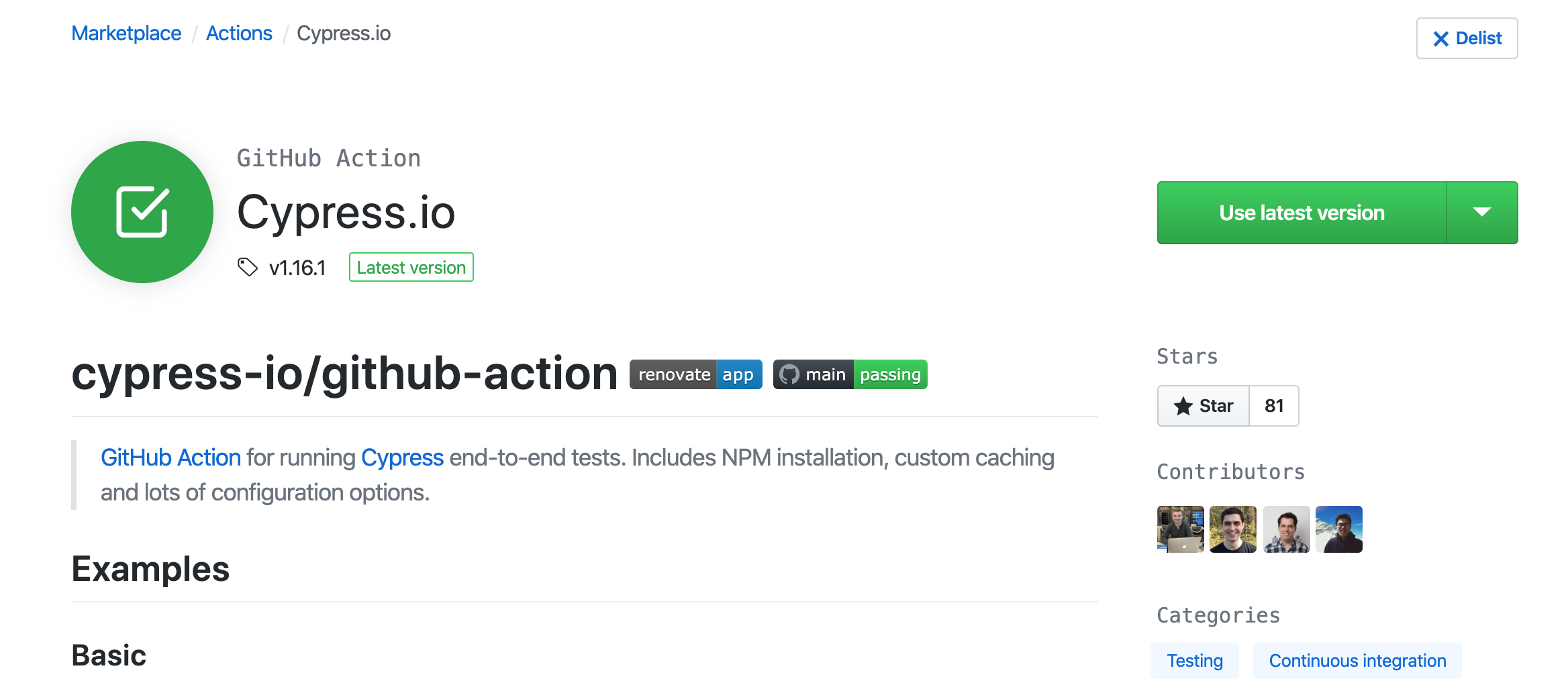
End-to-end web app testing
Cypress GitHub Action
name: End-to-end tests
on: [push]
jobs:
cypress-run:
runs-on: ubuntu-latest
steps:
- uses: actions/checkout@v1
- uses: cypress-io/github-action@v1(does npm install and caching, runs the tests correctly, can build app and start server and more)
Cypress GitHub Action
name: Chome tests
on: [push]
jobs:
cypress-run:
runs-on: ubuntu-latest
steps:
- uses: actions/checkout@v1
- uses: cypress-io/github-action@v1
with:
browser: chromeUse parameters to control behavior
Cypress GitHub Action
name: Record test results
on: [push]
jobs:
cypress-run:
runs-on: ubuntu-latest
steps:
- uses: actions/checkout@v1
- uses: cypress-io/github-action@v1
with:
record: true
env:
CYPRESS_RECORD_KEY: ${{ secrets.cy_token }}Cypress GitHub Action
name: Parallel tests
on: [push]
jobs:
cypress-run:
strategy:
matrix:
machines: [1, 2, 3]
runs-on: ubuntu-latest
steps:
- uses: actions/checkout@v1
- uses: cypress-io/github-action@v1
with:
record: true
parallel: true
env:
CYPRESS_RECORD_KEY: ${{ secrets.cy_token }}
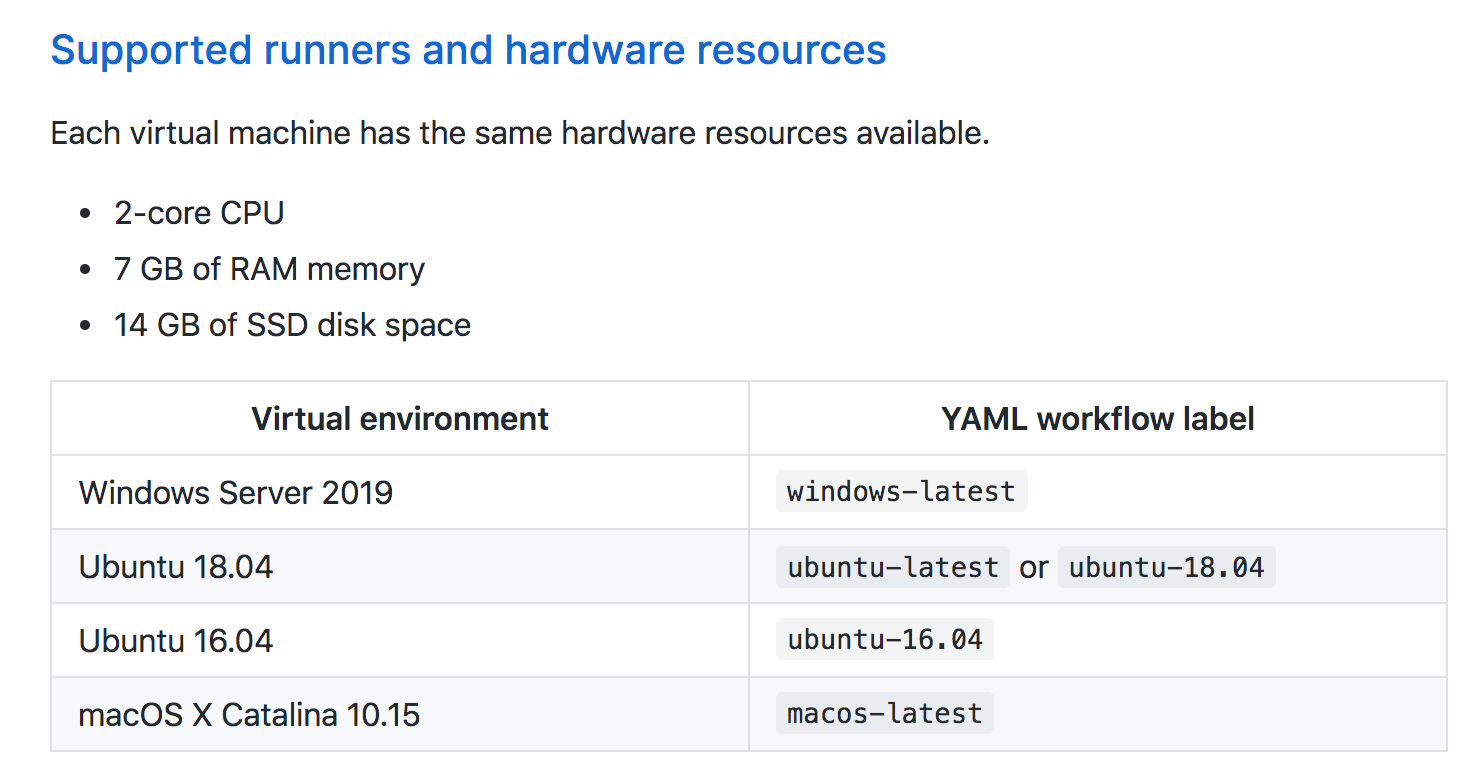
Cypress GitHub Action
parallel-runs-across-platforms:
strategy:
matrix:
os: ['ubuntu-latest', 'windows-latest', 'macos-latest']
machines: [1, 2]
runs-on: ${{ matrix.os }}
steps:
- uses: actions/checkout@v1
- uses: cypress-io/github-action@v1
with:
record: true
parallel: true
group: Parallel 2x on ${{ matrix.os }}
env:
CYPRESS_RECORD_KEY: ${{ secrets.cy_token }}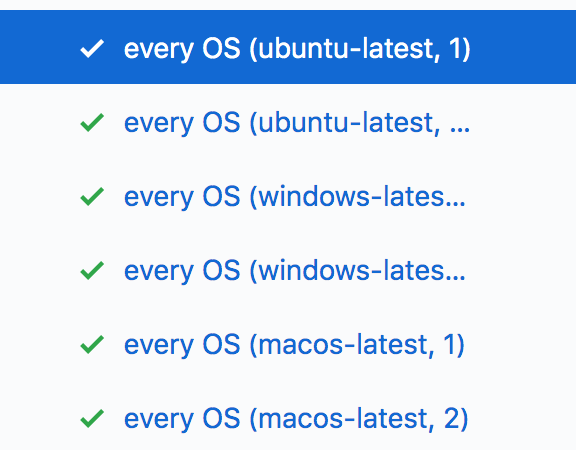
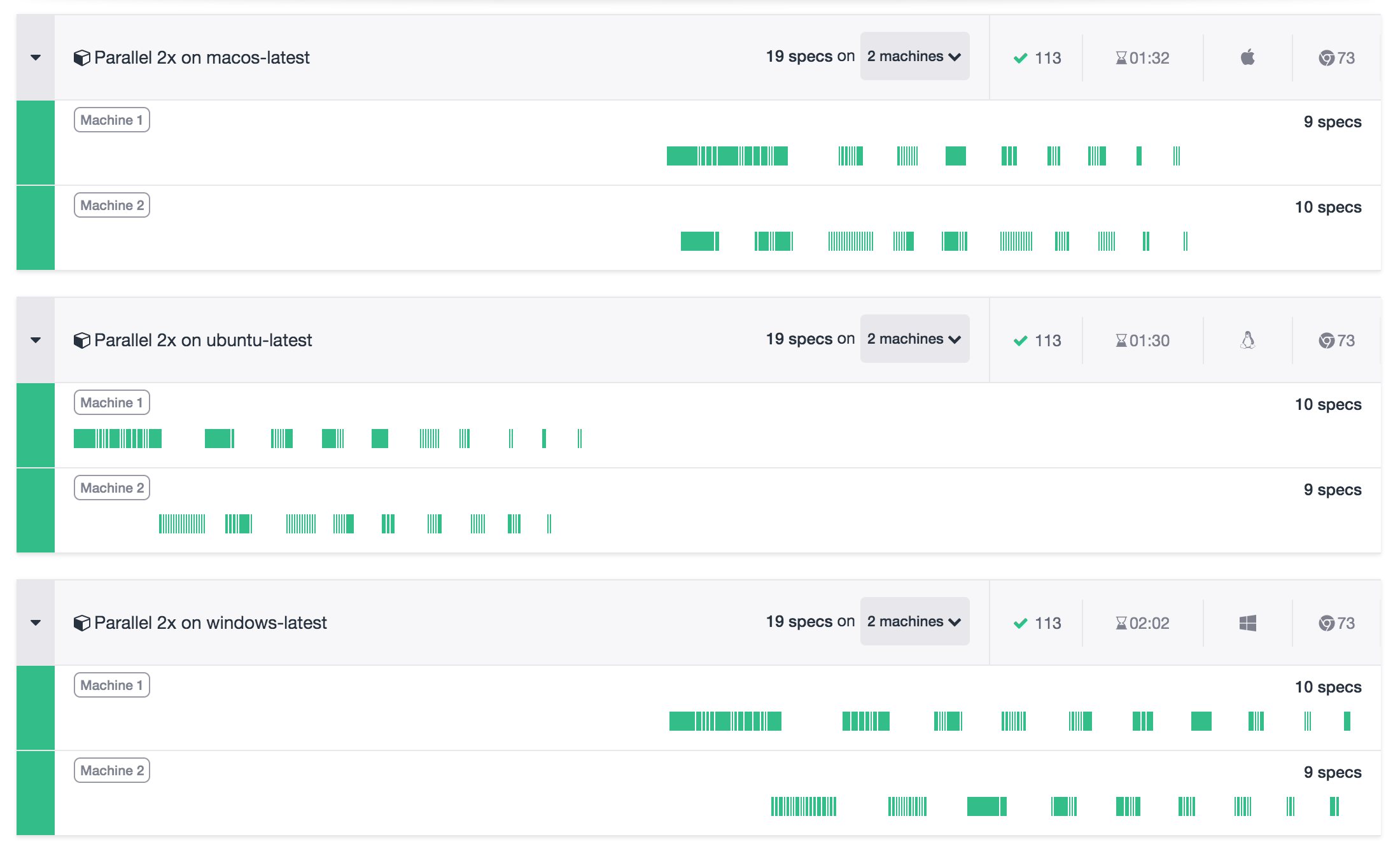
recorded parallel runs
GH Actions
GH Workflows
- Powerful CI
- Lots of free resources
- Great integration with GitHub
- JavaScript on CI 🎉
Thank you 👏


